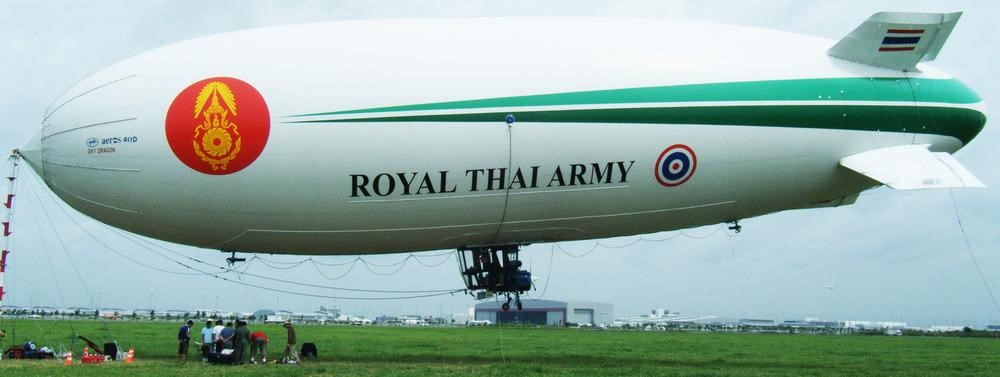Andrew McGregor
February 19, 2010
Amid rumors that the program has been grounded, the Royal Thai Army maintains it is in the last stages of preparing a controversial U.S.-built manned airship for deployment in the military’s struggle against Islamist separatists active in southern Thailand.
 The Royal Thai Army’s Airship (Aria International)
The Royal Thai Army’s Airship (Aria International)
The Thai military has been heavily criticized recently by those who allege the armed forces have gone on a spending spree, buying expensive but unproven and potentially useless technology as the nation tries to recover from a financial crisis. Many Thai analysts wonder whether the same amount of investment in human assets or less mobile but cheaper ground surveillance systems would not realize similar results. Even one of the airship’s operational support team questioned the airship’s usefulness on two grounds: the heavily forested terrain of south Thailand differs greatly from places where balloon surveillance is currently used, such as the deserts of Iraq and Afghanistan; secondly, the insurgents specialize in hit-and-run attacks and do not converge in large groups long enough to be noticed by an airship (The Nation [Bangkok], February 4).
The Aeros 40D S/N 21 (Sky Dragon) is made by California-based Worldwide Aeros. Nearly 50 meters long, the Sky Dragon has an operational range of 560 km, a ceiling of 10,000 feet and can travel at a maximum speed of 88 kph.
The airship was procured through a contract with a U.S. defense industry middleman, Aria International. Allegations of corruption in the procurement process were cited as one of the reasons behind demonstrations by the red-shirted United Front for Democracy against Dictatorship (UFDD) opposition movement at Royal Thai Army headquarters (Thailand News Agency, January 20). The charges were refuted by Aria VP Art Sullivan. “To be specific and blunt, Aria has never paid anyone to gain or retain this contract.” Defending the airship against allegations it could be easily shot down by small-arms fire, Sullivan stated. “In fact, you could put 20 bullet holes in this airship and it would still continue to fly. Nonetheless, we operate the airship at a safe altitude above the range of small arms.” Sullivan also challenged exaggerated cost figures that appeared in the Thai media, insisting the contract was for a fixed $9.7 million (Letter to the Editor, The Nation, February 8).
The procurement controversy is part of larger public criticism of wasteful defense spending on a bloated defense establishment that has been slow to follow the “leaner and meaner” trend of other militaries (The Nation [Bangkok], February 5). Initially, it was planned to purchase two of the airships, though the acquisition of another airship now looks unlikely in light of the procurement controversy.
Delays in the program were attributed to problems in obtaining a U.S. release for the technology used in the airship’s complex camera system (worth more than the rest of the airship and its support system). The high-definition, thermal-detecting surveillance cameras can record images night or day, in any kind of weather.
Once deployed, the airship system (described by Aria as a “surveillance programme, not an airship programme”) will be operated by 55 officers and NCOs distributed between command, air, ground and support operations. Airship operations will be supported by three HU-1H helicopters, one in each of the southern provinces of Narathiwat, Yala and Pattani. On the ground, a 22-ton Grizzly Armored Personnel Carrier acts as a mobile command-and-control vehicle. The airship also requires the construction of a hangar and support facility in Pattani province.
The U.S. military has deployed cable-tethered blimps – aerostats – as part of its RAID (Rapid Aerostat Initial Deployment) surveillance system in Iraq and Afghanistan (Defense Industry Daily, July 18, 2009). Though the aerostats use low-pressure gas to prevent being brought down by a single bullet-hole, insurgents have discovered that if you put enough bullet-holes in an aerostat, it needs to be brought down for maintenance. In many cases this has reduced a projected 30-day aerostat deployment to a length of only several days.
Though their effectiveness in South Thailand is yet unproven, airships may soon play an important role on the modern battlefield. The U.S. Defense Advanced Research Projects Agency (DARPA) and the U.S. Air Force have plans to launch a massive unmanned military airship capable of flying a ten-year mission at 70,000 feet. Dubbed ISIS (Integrated Sensor Is Structure), the airship will be 1,000 feet in length, with two enormous radar antennas integrated into the framework of the airship and an advanced radar system designed by Raytheon. According to DARPA, “ISIS will revolutionize theater-wide surveillance, tracking and fire control” (Defense News, May 11, 2009). A prototype built by Lockheed is scheduled to make its first flight in 2013.
This article first appeared in the February 18, 2010 issue of the Jamestown Foundation’s Terrorism Monitor
